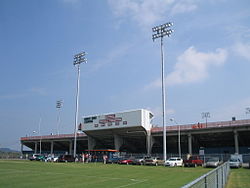Burke-Tarr Stadium
 |
|
| Location | Jefferson City, Tennessee |
|---|---|
| Coordinates | 36°7′19.31″N 83°29′8.15″W / 36.1220306°N 83.4855972°WCoordinates: 36°7′19.31″N 83°29′8.15″W / 36.1220306°N 83.4855972°W |
| Owner | Carson–Newman College |
| Operator | Carson–Newman College |
| Surface | FieldTurf |
| Opened | October 22, 2005 |
| Tenants | |
| Carson–Newman College Eagles (NCAA) (2005–present) | |
Burke–Tarr Stadium is a football stadium located in Jefferson City, Tennessee on the campus of Carson–Newman College.
The original structure, consisting primarily of concrete-supported wooden bleachers and a small press box, was constructed in 1966 to serve as the home for the Carson–Newman Eagles football, then a member of the NAIA.
From 1967 to 2004, the Eagles compiled a 192–37–2 record at the original stadium, which hosted three of the team's five NAIA National Football Championship victories in 1986, 1988, and 1989. After the team moved to NCAA Division II in the early 1990s, the team ran off a home winning streak that stretched from a 62–31 loss to New Haven in 1993, to a 38–28 loss to conference foe Presbyterian on October 6, 2001, a span of 36 regular season games; Northern Colorado defeated the Eagles, 30–29, in a Division II semi-final game in 1997. Since that loss, the Eagles have run off another 22-game home winning streak, discounting a 2005 loss at Jefferson County High School, including two playoff games against Fayetteville State. Since moving up in classification, the Eagles are 63–2 at Burke–Tarr Stadium.
Much of the success at the stadium has come under the coaching era of Ken Sparks, who ranks fourth in most wins among active NCAA coaches.
The new Burke–Tarr Stadium was erected within nine months of the original's demolition, and was dedicated on October 22, 2005 during Homecoming festivities as the Eagles defeated Lenoir–Rhyne, 33–6. The facility's main stands consist primarily of steel and aluminum, as concrete prices at the time of construction made it impossible to afford a concrete structure. The metal design allowed for four additional entrances to the main stands via stairwells from the ground level, in addition to the entrances on either end of the stadium. The stands contain press box supported by two steel and brick columns, leaving a great deal of space underneath for concessions stands, merchandise booths, and restroom facilities.
...
Wikipedia
